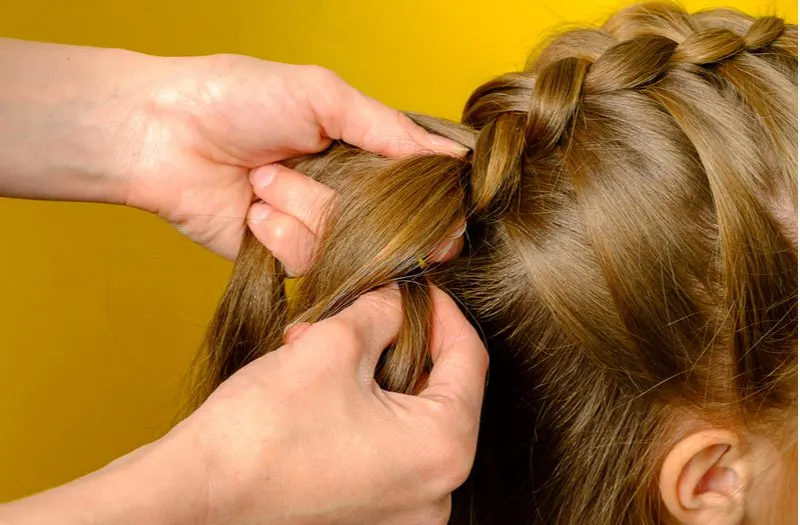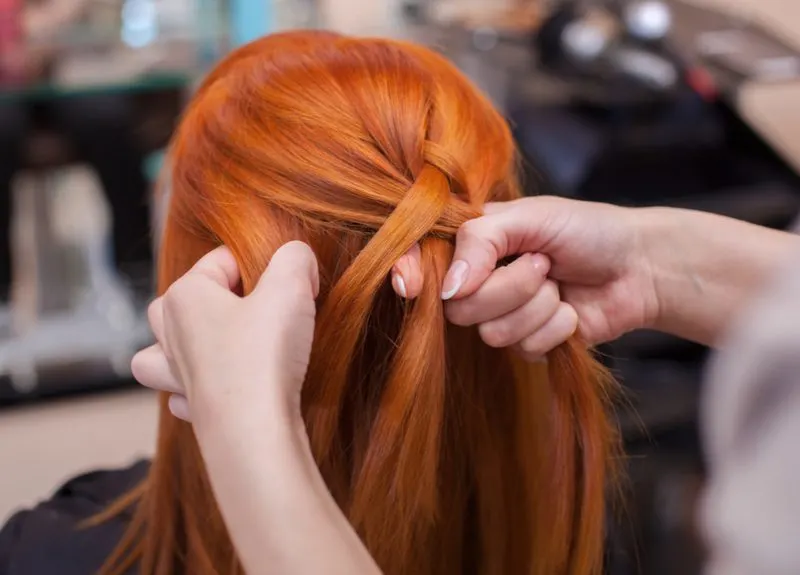Jump to:
French braided hair looks elegant and can be worn casually, professionally, or on a date. Though it may look challenging, it will be second nature to you once you get your system down.
There are a few secrets to crafting the perfect French braid. Luckily, we will give you plenty of tips for French braiding your own hair so you can start styling it.
Looking for French Braiding Tips?

zheka0210/Shutterstock
French braiding is a hair-styling technique that is quite similar to a standard braid; the only difference is adding hair to the sections as you go. If you haven’t tried French braiding yet, you may want to give it a try.
When you hold back your hair with a loose French braid, you will spread the weight of your hair across more of your scalp.
If you suffer from ponytail headaches, French braiding may be a good alternative for you to try. All you need is a few helpful tips for French braiding your own hair to get started.
Other Benefits of French Braiding Hair:
- You can easily keep bangs and flyaways out of your face.
- French braids look stylish in just about any atmosphere.
- Your French braid will last all day (or even days!)
- Keeping your hair in braids can reduce friction on your pillow while you sleep, helping to prevent breakage.
- Your hair will retain more moisture in a French braid.
- When your hair is in braids, it can protect it from the sun and outdoor pollution.
How to French Braid Your Own Hair
Practice makes perfect, and the best way to get good at French braiding your own hair is to do it over and over again. Luckily, you can do a few things to make your practice runs a little easier. Here are some tips for French braiding your own hair:
Practice With Damp Hair
If you are new to the world of French braiding, practicing your braids with damp hair can make the process easier. Wet hair tends to be easier to maneuver as you twist and weave your hair. Some people find it easier to feel the sections of hair as they start reaching to the back of their heads.
Use Bigger Chunks of Hair
French braiding takes a lot more time than more basic hairstyles. It takes a lot of patience to grab small sections, especially if you are new to the French braid.
When you grab chunks of hair to add to your braid, start by adding more significant pieces. Though it will likely not be the look you’re going for, it will help you get the movement down.
French Braid in Spare Time
It may take a few tries to get your French braid down. We suggest practicing while you’re watching your favorite movie or TV show to get plenty of practice.
Surprisingly, some people find that not looking in a mirror makes it easier to pay attention to feeling their hair. Plus, once you get to the back of your head, you won’t be able to see anyway.
Tips For French Braiding Your Own Hair: Step-By-Step

Evgeniy Agarkov/Shutterstock
Here is a step-by-step process along with tips for French braiding your own hair:
Remove All Tangles
Frizz can make braiding challenging, so you want your hair to be as smooth as possible before you get started. Use a detangling brush to remove all tangles in your hair. If your hair is frizzy, spritz a bit of no-frizz hair product on your hair.
Tips:
- You can braid your hair dry or damp. If you French braid your hair wet, you will have wavy hair once you take it out.
- Freshly-washed hair will be harder to braid. If you washed your hair within the past couple of days, use a texturizing product to add some grip.
Create Sections
Brush your hair in the general direction of where you want your braid to go. Then, use your brush to grab the middle section of hair on the top of your head.
Ideally, this chunk of hair should extend from temple to temple and reach the crown of the head. Break this large chunk of hair into three equal-sized sections.
Tips:
- If you have bangs, you can either brush them out of this section or include them in the area.
- The initial chunk of hair will not affect how full your French braid will be, so start with a small 3-4 section of hair for best results.
- Run your fingers through each subsection to ensure you have three evenly-sized pieces.
Start Your Braid
Start with a traditional braid. Cross the left section over the center section. Then cross the right section over the center section.
Hold two subsections with one hand and the other section in the other. Cross the left piece over the center, then the right over the center. Repeat this 2-3 times.
Add In Other Pieces of Hair
As you continue with the process of a standard braid, add in pieces of other hair, starting with the right side. Each time you cross one section over the other, grab a chunk of hair from the same side as the section.
Tips:
- It doesn’t matter how big the chunks are you grab at each time. However, smaller pieces typically look better in the end result.
- Grabbing larger sections may be easier for beginners and will take less time to complete.
Repeat Step Four Until All New Hair is Included in Braid
Continue grabbing chunks of hair as you braid the left section over the center section, then the right over the center section, and so on. Once you reach the nape of your neck, you should encompass all of your hair into the French braid.
Tips:
- When working in new sections, grab horizontal pieces from your hairline by your face and neck.
- Whether you choose big or small chunks to weave in, do your best to grab the same size each time for a consistent look.
Finish With a Standard Braid
After you’ve gathered all of your hair into the French braid, group the ends together, create three evenly-sized sections, and finish braiding with a standard 3-section braid.
Tips:
- You can braid the rest of your hair as far down as you like. You can even opt to secure your hair with an elastic close to the nape of your neck.
- Keep a firm grip on hair as you work through the beginning of this process to prevent a loose-looking French braid.
Final Touches
Secure your French braid with a hair elastic. If you have any frizz or flyaways, use a little hairspray to keep them under control. If you left out bangs, style them as you usually would.
Tips:
- Avoid securing your braid with a rubber band. Once you remove it, you risk damaging or pulling out chunks of hair.
- The ADA recommends using cloth-covered bands to avoid damage and hair loss.
Additional Tips For French Braiding Your Own Hair

dimid_86/Shutterstock
As you continue to practice your new hairstyle, keep these additional tips for French braiding your own hair in mind.
Avoid Bumps For a Smooth Braid
One challenge many French braiders come across is bumps appearing in their sections. Do your best to brush your fingers through each section of new hair to keep your French braid looking sleek and bump-free.
Add Volume to Your French Braid
If you have thin or fine hair, you may notice that your French braid falls a little flat – literally. Start by adding some volumizing mousse before braiding your hair. After you secure your French braid with an elastic, gently pull apart each braid to fluff it out.
Keep Your Braid Tight From Top to Bottom
If you notice the bottom part of your French braid seems a little loose or has a “bulging” appearance, you may be loosening your grip towards the end.
French braiding can cause a little strain on your arm muscles, but do your best to pull each section taut and keep a firm grip on your braid. Keep your hands as close to your scalp as possible rather than braiding up in the air.
Braid Without Looking in the Mirror
When using a mirror, you’re looking at a backward image. French braiding requires you to pay close attention to your rights and lefts, and a mirror can add confusion.
As you French braid your hair, focus on the feelings in your fingers rather than relying on what you’re looking at. You’ll be surprised at how powerful your sense of touch is.
Frequently Asked Questions
Here are the most frequently asked questions regarding tips for French braiding your own hair.
Is it better to braid your hair wet or dry?
You don’t want to braid your hair when completely wet because it will keep your hair from fully drying. Damp hair can help you get your technique down and leave you with bouncy waves when you take your French braid apart.
Is it hard to French braid your own hair?
Although many people assume French braiding your own hair is challenging, it is easier than you might think.
A French braid only has a few extra steps if you already know how to do a standard three-strand braid. It does, however, take more time to French braid than to do a standard braid.
Are French braids good for your hair?
French braids surprisingly have a lot of benefits. They distribute hair weight evenly along your scalp and reduce friction on your hair.
French braiding your hair before bed and sleeping on a silk pillowcase is a great technique to prevent tangles in the morning, among other benefits.
Do French braids cause breakage?
When there is friction on your hair, it can cause hair damage. French braiding is actually a protective hairstyle that keeps your hair in place and may help prevent damage, especially at night.
Can you shower with French braids?
Yes, you can shower with French braids. If you’d like to keep your braids dry, use a shower cap to prevent water from touching them. You can also condition your French braids by gently massaging the conditioner into your braids rather than rubbing them.
So, What Are the Best Tips For French Braiding Your Own Hair?
French braiding is a hairstyle that not only looks good for any occasion but is also a protective hairstyle that offers multiple benefits. When French braiding your hair, keep the process of a standard braid and add chunks of hair to each outer section as you layer them over one another.
Ultimately, one of the best tips for French braiding your own hair is to give yourself plenty of time to practice. Once you get your general technique down, you can start refining your process.
